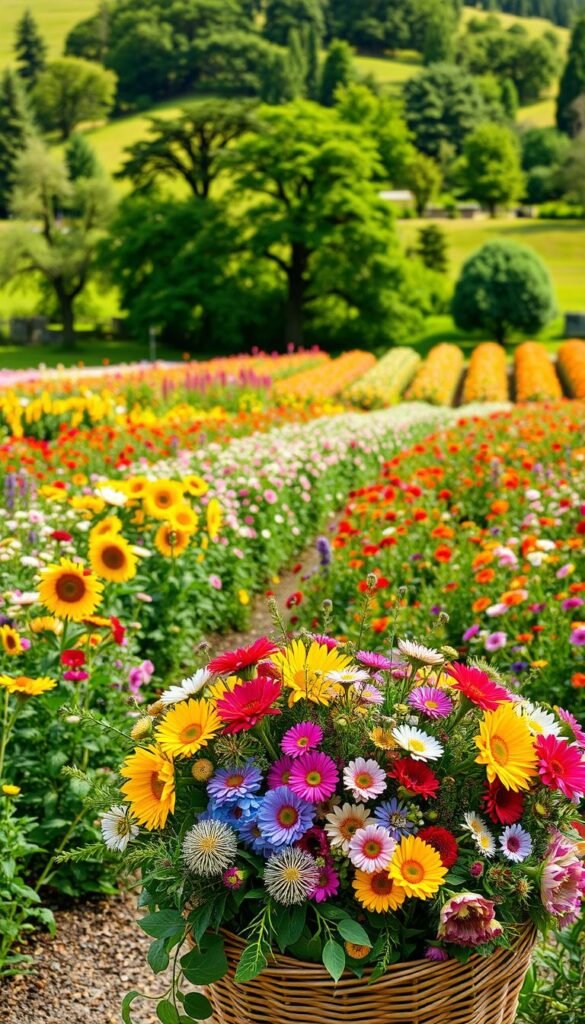Imagine stepping outside to gather armfuls of fresh blooms for your kitchen table or to share with friends. Unlike traditional gardens meant for outdoor display, a cut flower garden focuses on growing plants specifically for harvesting. This approach lets you enjoy vibrant arrangements indoors while keeping your outdoor space productive all season.
You’ll learn to think like a floral designer by understanding five key plant groups: bold focals, vertical spikes, round discs, lacy fillers, and wispy airy bits. These categories work together to create balanced bouquets that look professionally crafted. Annuals like zinnias and sunflowers form the backbone of most cutting beds, offering quick growth and continuous blooms from spring through fall.
What makes this style of gardening perfect for newcomers? You’ll see results fast—many annuals bloom within 6-8 weeks of planting. Small spaces thrive too: a 4×8 foot bed or even containers can produce enough stems for weekly arrangements. Best of all, you’re not limited by pricey florist bouquets that fade quickly. Your homegrown flowers stay fresher longer when cut at the right time.
Ready to explore easy-to-grow options? Discover beginner-friendly flowers that bring bold colors and textures to your space while requiring minimal upkeep. From pest-repelling marigolds to drought-tolerant cosmos, you’ll find plants that suit your climate and style.
Preparing for Your Cut Flower Garden
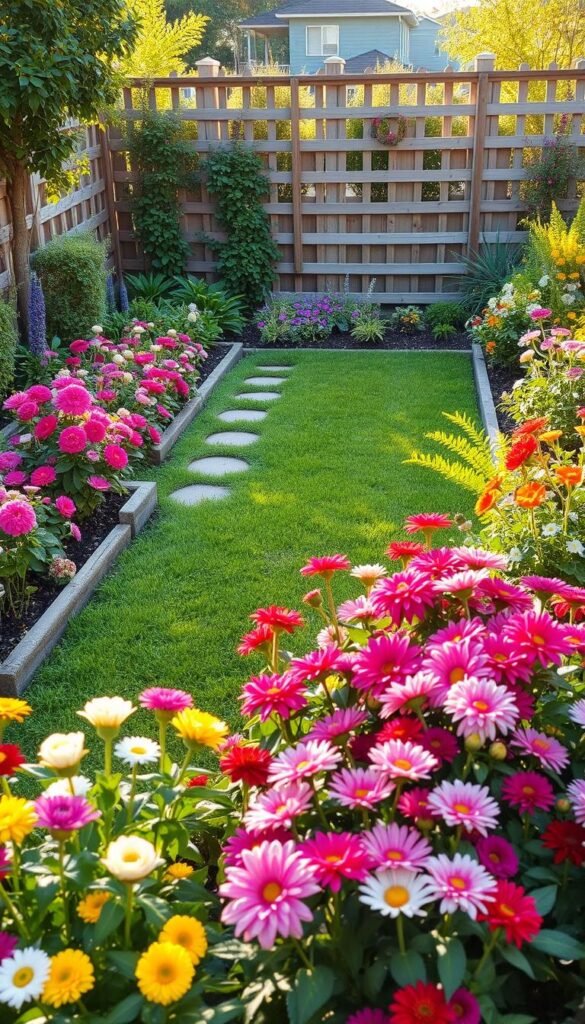
Transforming your available area into a bloom-filled oasis begins with smart planning. Whether you’re working with a balcony or backyard, success starts with matching your vision to practical realities like sunlight exposure and weekly care capacity.
Assessing Your Space and Budget
A 4’x4′ raised bed proves you don’t need acres to create beauty. Packed with zinnias and cosmos, this compact setup can produce 20+ bouquets annually. Urban growers often thrive with containers—opt for 12-inch-deep pots for dwarf varieties like marigolds or petite sunflowers.
New growers should resist the urge to oversize their plots. Begin with one bed or a few containers, then expand as confidence grows. Focus investments on quality soil and seeds rather than fancy equipment—a beginner gardening checklist covers essentials without clutter.
Gathering Essential Tools and Supplies
Three items form your core toolkit: sharp pruners for clean cuts, durable gloves, and a watering can. Optional extras like floral tubes help preserve stems but aren’t required initially. Prioritize fast-draining soil mixes over decorative pots—your plants care more about root space than container aesthetics.
Track your weekly availability realistically. If weekends are busy, choose low-maintenance varieties like celosia that thrive with minimal attention. Remember: thriving arrangements come from consistent care, not constant labor.
Selecting the Ideal Site and Optimizing Sunlight
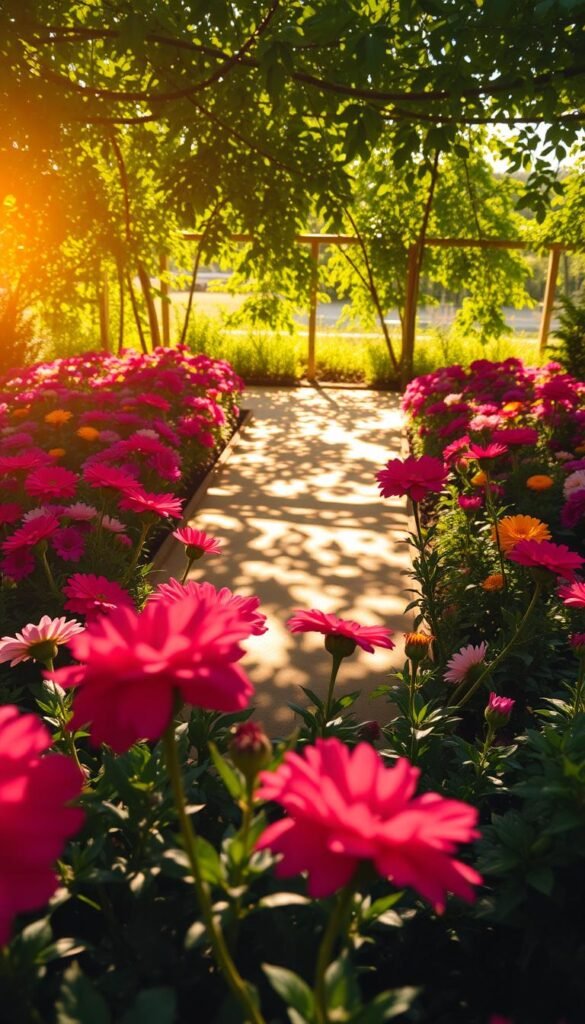
Where you plant matters as much as what you grow. Most flowers need sunlight like bread needs an oven—without enough, they won’t rise to their full potential. Start by mapping your space three times: morning, noon, and late afternoon. Look for areas that stay bright for six hours straight.
Finding the Perfect Spot in Your Yard or Balcony
Watch how shadows creep across your garden throughout the day. A spot that’s sunny in spring might get shaded by tree leaves by summer. South-facing spaces usually win for sun exposure, but east-facing areas work well for morning-loving blooms.
“Sunlight is the fuel that powers your blooms—measure it like you’re baking a cake.”
Pair sun-hungry zinnias with tomatoes in mixed beds—they’ll thrive under the same conditions. For spots getting 4-6 hours of light, try these performers:
| Flower Type | Sun Needs | Bloom Time |
|---|---|---|
| Snapdragons | Partial shade | Spring to fall |
| Nicotiana | Dappled light | Summer nights |
| Fuchsia | Morning sun | All season |
Balcony growers: rotate pots weekly so all sides get equal light. Use vertical stands to elevate containers above rail shadows. Remember—sun patterns shift with seasons. What works this year might need tweaking next spring.
Understanding Soil Needs and Raised Bed Benefits
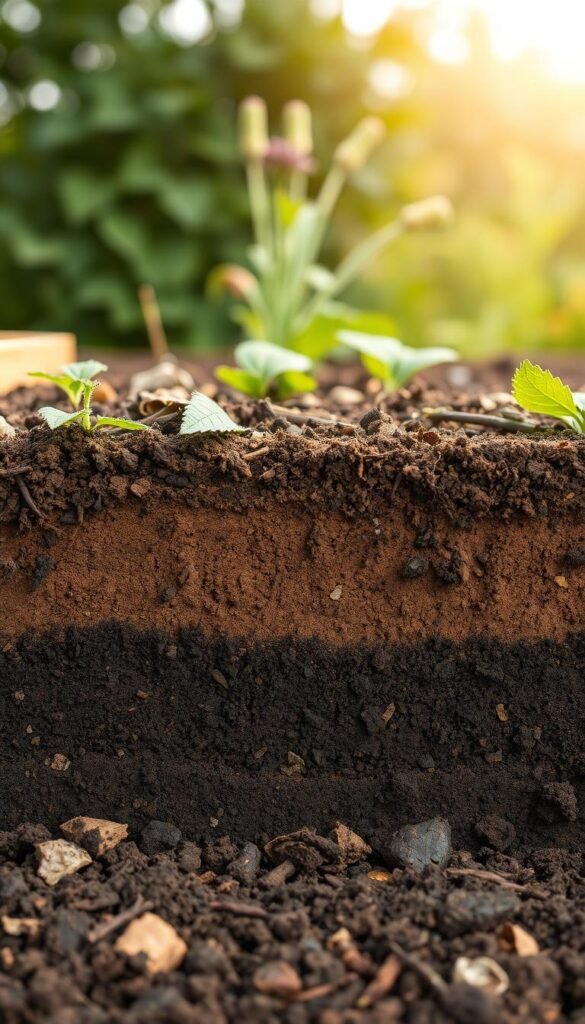
Your garden’s success begins beneath the surface. Think of soil as a living pantry—it stores nutrients, regulates moisture, and supports root systems. The right blend keeps your flowers thriving while preventing common issues like soggy roots or nutrient deficiencies.
Building a Soil Recipe for Long-Lasting Blooms
Mix 50% bagged raised bed soil for structure, 40% compost for slow-release nutrients, and 10% coconut coir for moisture control. This combination creates fluffy, fertile ground that lets roots breathe while holding water effectively. Leaf-based compost feeds beneficial microbes, boosting soil life for healthier plants.
Add a handful of Flower-Tone fertilizer to each planting hole. Its phosphorus-rich formula shifts energy from leaves to blooms, creating sturdier stems and brighter petals. Unlike synthetic options, this organic choice won’t burn delicate roots.
Choosing Raised Beds for Better Drainage and Organization
Elevated planters solve multiple challenges at once. Their loose soil warms faster in spring, letting you plant weeks earlier. Improved drainage prevents root rot—a common killer of young flowers. For pest control, line bed bottoms with hardware cloth before filling.
Raised beds simplify maintenance through contained spaces and defined pathways. Our complete raised bed gardening guide shows how to build affordable versions using cedar boards or repurposed materials. Wrap sides with chicken wire to deter nibbling rabbits while maintaining airflow.
How to Start a Cut Flower Garden for Beginners: Budget-Friendly Steps
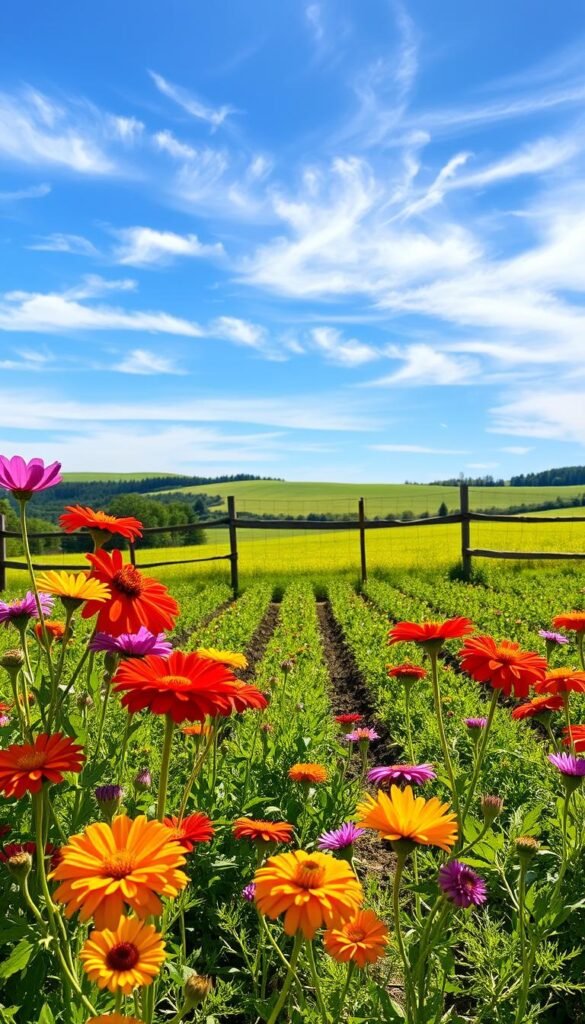
Your journey to vibrant bouquets begins with seeds meeting soil—no complex setups required. Direct-sow varieties let you skip indoor seed trays and jump straight into growing. Focus on varieties that thrive when planted right in the ground, giving you more time to enjoy results than wrestle with transplants.
| Flower | Sowing Depth | Days to Bloom | Height |
|---|---|---|---|
| Zinnia | 1/4 inch | 60-70 | 24-36″ |
| Cosmos | 1/4 inch | 70-84 | 36-48″ |
| Sunflower | 1 inch | 75-95 | 60-72″ |
| Marigold | 1/2 inch | 45-50 | 12-24″ |
Stagger plantings every 2-3 weeks for nonstop color. Sow a row of quick-growing marigolds between slower zinnias—they’ll fill gaps while taller varieties develop. This flower garden trick ensures something’s always ready to cut.
Pair round blooms like calendula with spiky snapdragons for instant bouquet structure. “Mixing shapes creates depth,” says floral designer Emma Carter. “Start with three forms—disk, spike, filler—for arrangements that look curated, not chaotic.”
Track your progress with a simple calendar. Mark sowing dates and expected bloom times to maintain steady harvests. By late summer, you’ll have enough cut flowers for your kitchen table plus extras to gift—all from a packet of seeds costing less than store-bought roses.
This approach builds skills naturally. Master soil preparation this year, then experiment with succession planting next season. Each bouquet becomes a milestone in your growing journey.
Choosing the Best Cut Flower Varieties and Seed Sources
Creating eye-catching arrangements begins with selecting plants that play different roles. Aim for three types: tall statement makers, mid-height fillers, and delicate accents. Mixing bloom times ensures fresh picks from spring’s first cosmos to autumn’s final zinnias.
Recommended Flowers for Stunning Bouquets
Zinnias and sunflowers form the backbone of beginner-friendly beds. ‘Benary’s Giant’ zinnias produce sturdy stems perfect for vases, while ‘Mammoth’ sunflowers add drama. Pair them with frilly ‘Cupcake’ cosmos and fragrant sweet peas for texture.
Stagger plantings every 14 days. Sow quick-growing marigolds between slower varieties. This trick fills gaps while taller plants develop. “Start with five types max,” advises Oregon grower Lila Nguyen. “Master those before expanding your palette.”
Reliable Vendors and Budget-Friendly Seed Options
Johnny’s Selected Seeds offers professional-grade varieties, while Burpee provides foolproof classics. Eden Brothers excels in heirlooms like ‘Chocolate’ sunflowers. Local nurseries stock seeds adapted to your region’s climate—ask for mildew-resistant zinnias in humid areas.
Prioritize direct-sow seeds to skip indoor setups. A $3 packet of cosmos yields 50+ blooms. Compare prices per seed count—some vendors offer bulk discounts. Remember: quality soil matters more than fancy seed trays for success.
Implementing Direct-Sow Techniques for New Gardeners
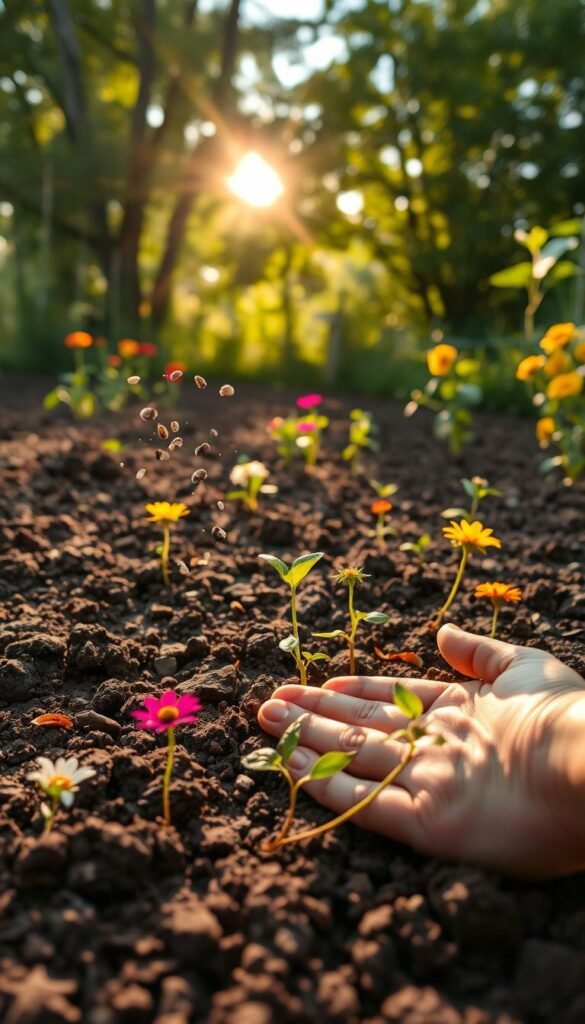
Unlock the simplicity of growing vibrant blooms right where they’ll flourish. Direct sowing lets you skip indoor seed trays and work with nature’s schedule. This method works wonders when soil temperatures hit 60°F—typically when spring days feel consistently warm.
Why Soil Temperature Matters
Test your garden bed with a basic thermometer. Push it 2″ deep in morning shade for accurate readings. If you don’t own one, try this trick: if barefoot walking feels comfortable on the soil, seeds will germinate happily.
| Flower | Soil Temp | Days to Bloom | Spacing |
|---|---|---|---|
| Zinnias | 70°F+ | 60 | 12″ |
| Cosmos | 60°F | 70 | 18″ |
| Sunflowers | 55°F | 75 | 24″ |
| Marigolds | 65°F | 45 | 8″ |
Zinnias thrive when sown directly—their roots dislike transplanting. Plant them ¼” deep after frost danger passes. Keep soil moist until sprouts appear, then let natural rainfall take over. You’ll see first blooms just as summer heat arrives.
Stagger plantings every three weeks for continuous color. Late starters planted in June still produce until frost. One packet of seeds yields enough flowers for weekly bouquets, costing less than a single grocery store arrangement.
“Direct sowing lets the plants decide when they’re ready—nature’s wisdom beats any greenhouse schedule.”
This approach saves money and time. No need for grow lights or peat pots. Your garden becomes a self-sufficient studio where seeds transform into cutting-ready stems with minimal intervention.
Seasonal Considerations and Frost Timing
Timing your planting around nature’s schedule ensures blooms survive spring’s mood swings. Frost acts like an uninvited guest—it shows up late and ruins the party. Knowing your area’s average last spring frost date helps you avoid wilted seedlings.
Planning for Last Frost Dates
Check your local agricultural extension website for frost date maps. Most regions range from early March (Texas) to late May (Maine). Tender annuals like zinnias need soil above 60°F, so wait 1-2 weeks after frost risks pass before sowing.
Row covers stretch your growing window. These lightweight fabrics trap heat, raising soil temps by 6-8°F. Use them over newly planted beds if surprise cold snaps strike. For single plants, cloches made from milk jugs work as mini greenhouses.
Track soil warmth with a $5 thermometer. Push it 2″ deep at dawn—consistent 55°F readings mean go-time for most seeds. Pair this data with cold-hardy crops like kale or pansies to extend your harvest into winter months.
Remember: nature loves curveballs. Keep spare covers handy and celebrate each bloom as a victory against the elements.

